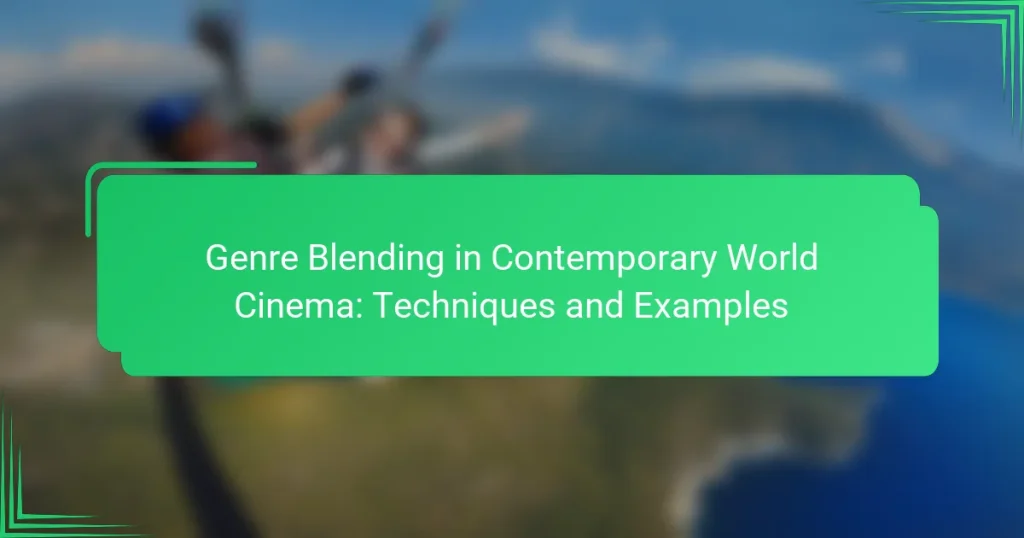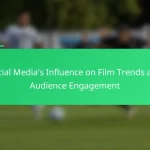In contemporary world cinema, genre blending has emerged as a powerful technique that enriches storytelling by merging elements from various genres. This innovative approach not only challenges traditional narrative structures but also enhances emotional depth, captivating audiences and inviting them to engage with films in fresh and unexpected ways.

What Techniques Are Used in Genre Blending in Contemporary Cinema?
Genre blending in contemporary cinema employs various techniques to create innovative storytelling experiences. These methods combine elements from different genres, resulting in unique narratives that challenge audience expectations.
Cross-genre storytelling
Cross-genre storytelling involves merging two or more distinct genres to craft a cohesive narrative. This technique allows filmmakers to explore complex themes and character dynamics that resonate with diverse audiences. For instance, a romantic comedy may incorporate elements of horror, creating tension while maintaining humor.
Successful cross-genre films often balance the characteristics of each genre, ensuring that neither overshadows the other. Examples include “Get Out,” which blends horror and social commentary, and “The Shape of Water,” combining fantasy with romance.
Hybrid narrative structures
Hybrid narrative structures utilize multiple storytelling techniques to enhance the viewing experience. This can include non-linear timelines, intertwining plotlines, or varying perspectives. By employing these structures, filmmakers can create layers of meaning and engage viewers on multiple levels.
Films like “Pulp Fiction” and “Cloud Atlas” exemplify hybrid narratives, where different stories intersect and influence one another. This approach invites audiences to actively piece together the narrative, fostering deeper engagement.
Visual and auditory fusion
Visual and auditory fusion combines stylistic elements from various genres to create a distinctive aesthetic. This technique can involve blending cinematography styles, color palettes, or sound design to evoke specific emotions or themes. For example, a film may use vibrant colors typical of musicals while incorporating the gritty realism of a thriller.
Directors like Edgar Wright often employ this fusion in their works, such as “Baby Driver,” where the rhythm of the soundtrack is intricately linked to the visual storytelling, enhancing the overall experience.
Character archetype mixing
Character archetype mixing involves combining traits from different genre archetypes to create more nuanced characters. This technique allows for richer character development and can challenge traditional roles, making them more relatable and complex. For instance, a hero may exhibit traits of both a traditional action protagonist and a comedic sidekick.
Films like “Deadpool” showcase this mixing, where the anti-hero embodies characteristics of both a villain and a comedic lead, appealing to a broad audience while subverting expectations.
Subverting genre conventions
Subverting genre conventions involves intentionally breaking or altering established genre rules to surprise the audience. This technique can lead to innovative storytelling that defies predictability, keeping viewers engaged and intrigued. For example, a horror film might introduce comedic elements, creating an unexpected tonal shift.
Movies such as “The Cabin in the Woods” exemplify this technique by playing with horror tropes while simultaneously critiquing them. By subverting conventions, filmmakers can create fresh narratives that resonate with contemporary audiences.

Which Films Exemplify Genre Blending?
Several contemporary films successfully blend genres, creating unique narratives that challenge traditional storytelling. These films often combine elements from different genres to enhance emotional depth and engage audiences in innovative ways.
Get Out (2017) – Horror and Satire
“Get Out” masterfully intertwines horror with social satire, addressing racial tensions in America. The film uses suspenseful elements typical of horror to critique societal issues, making viewers reflect on the real horrors of racism.
Key techniques include the use of unsettling imagery and a tense atmosphere, which serve to amplify the film’s satirical commentary. This combination not only entertains but also provokes critical thought about race relations.
Mad Max: Fury Road (2015) – Action and Drama
“Mad Max: Fury Road” blends high-octane action with dramatic storytelling, creating a relentless visual experience. The film’s action sequences are not just spectacles; they are deeply tied to character development and emotional stakes.
This fusion allows for a narrative that emphasizes survival and resilience in a post-apocalyptic world. The film’s pacing and visual storytelling techniques keep audiences engaged while exploring themes of redemption and sacrifice.
Parasite (2019) – Thriller and Comedy
“Parasite” skillfully merges thriller elements with dark comedy, offering a poignant critique of class disparity. The film oscillates between tension and humor, which enhances its commentary on social inequality and human behavior.
By blending these genres, “Parasite” creates a unique viewing experience that keeps audiences on edge while provoking laughter and reflection. The unexpected shifts in tone highlight the absurdities of the characters’ situations, making the film both entertaining and thought-provoking.
The Shape of Water (2017) – Fantasy and Romance
“The Shape of Water” combines fantasy with romance, telling a love story between a mute woman and a mysterious aquatic creature. This genre blending allows for a whimsical yet profound exploration of love and acceptance beyond societal norms.
The film’s use of fantastical elements enriches the romantic narrative, creating a visually stunning experience that captivates viewers. By merging these genres, it challenges conventional storytelling and invites audiences to embrace the extraordinary in everyday life.

How Does Genre Blending Impact Audience Reception?
Genre blending significantly enhances audience reception by creating unique cinematic experiences that defy traditional categorization. This approach captivates viewers, encouraging them to engage with films in new and unexpected ways.
Enhanced engagement through novelty
Blending genres introduces fresh narratives and unexpected twists, which can heighten viewer interest. For instance, a film that combines horror and comedy, like “What We Do in the Shadows,” keeps audiences on their toes with both scares and laughs. This novelty can lead to increased word-of-mouth promotion, as viewers are eager to share their unique experiences.
To maximize engagement, filmmakers should consider mixing elements that complement each other, such as action and romance, to create a more dynamic storytelling experience. This can lead to memorable moments that resonate with audiences long after the credits roll.
Broader appeal to diverse audiences
Genre blending allows films to attract a wider range of viewers by appealing to multiple tastes. A movie that incorporates elements of both science fiction and drama, like “Arrival,” can draw in fans from both genres, expanding its audience base. This broader appeal can be particularly beneficial in international markets, where cultural preferences vary.
Filmmakers should analyze their target demographics and consider incorporating popular elements from various genres to enhance marketability. This strategy can help ensure that the film resonates with diverse audience segments, increasing its chances of success.
Increased critical acclaim
Films that successfully blend genres often receive higher critical acclaim due to their innovative storytelling and artistic ambition. Critics appreciate the creativity involved in merging different styles, which can lead to nominations and awards. For example, “Get Out” combines horror with social commentary, earning it widespread recognition and accolades.
To achieve critical success, filmmakers should focus on crafting a cohesive narrative that seamlessly integrates various genre elements. This approach not only enhances the film’s artistic value but also positions it favorably in the eyes of critics and audiences alike.

What Are the Challenges of Genre Blending?
Genre blending presents several challenges, including the risk of alienating traditional audiences, balancing multiple tones and themes, and navigating marketing complexities. Filmmakers must carefully consider these factors to create a cohesive and engaging viewing experience.
Risk of alienating traditional audiences
One significant challenge of genre blending is the potential to alienate audiences who have specific expectations based on traditional genre conventions. For example, a horror-comedy may confuse viewers who prefer straightforward scares or pure humor.
To mitigate this risk, filmmakers should clearly communicate the film’s genre through trailers and promotional materials. Engaging with niche communities can also help gauge audience expectations and preferences.
Balancing multiple tones and themes
Successfully blending genres requires a delicate balance of tones and themes. A film that shifts too abruptly between comedy and drama, for instance, may leave viewers feeling disoriented or unsatisfied. Maintaining a consistent emotional thread is crucial.
Filmmakers can achieve this by establishing a strong narrative foundation and ensuring that character arcs resonate across genres. Testing the film with focus groups can provide valuable feedback on tone consistency.
Marketing complexities
Marketing a genre-blending film can be complex due to the need to appeal to diverse audience segments. Traditional marketing strategies may not effectively convey the film’s unique appeal, leading to confusion or misinterpretation.
To navigate these complexities, filmmakers should develop targeted marketing campaigns that highlight the film’s unique aspects. Collaborating with influencers from different genres can also broaden reach and attract varied audiences.

How Can Filmmakers Successfully Blend Genres?
Filmmakers can successfully blend genres by understanding audience expectations, researching effective combinations, and experimenting with narrative techniques. This approach allows for innovative storytelling that resonates with diverse viewers.
Understanding audience expectations
To blend genres effectively, filmmakers must first grasp what audiences anticipate from specific genres. Each genre carries its own conventions and tropes, which viewers expect to see. For instance, a horror-comedy should balance scares with humor to meet audience expectations.
Filmmakers can gauge these expectations through audience feedback, market research, and analyzing successful films. Engaging with viewers on social media or film forums can provide insights into what elements resonate most.
Researching successful genre combinations
Studying films that have successfully combined genres can offer valuable lessons. Notable examples include “Get Out,” which blends horror and social commentary, and “The Shape of Water,” merging romance with fantasy. These films demonstrate how effective genre blending can enhance storytelling.
Filmmakers should compile a list of successful genre hybrids and analyze their narrative structures, character development, and thematic elements. This research can inform their own projects and inspire unique combinations.
Experimenting with narrative techniques
Experimentation is key to blending genres. Filmmakers can play with narrative techniques such as nonlinear storytelling, unreliable narrators, or mixed media to create a fresh experience. For example, using animation within a live-action film can introduce a whimsical element to a serious narrative.
It’s important to maintain coherence in the story while experimenting. Filmmakers should test their ideas through storyboards or short films to see how well the genres mesh. Feedback from test audiences can help refine the final product and ensure that the blend is effective.

What Are the Future Trends in Genre Blending?
Future trends in genre blending are likely to focus on innovative storytelling techniques and the integration of diverse cultural elements. Filmmakers will increasingly experiment with hybrid genres to create unique narratives that resonate with global audiences.
Increased Use of Technology
Advancements in technology will play a significant role in genre blending. Filmmakers are leveraging virtual reality, augmented reality, and sophisticated CGI to merge genres in ways that were previously impossible. This allows for immersive experiences that can combine elements from horror, sci-fi, and drama seamlessly.
For example, films like “Ready Player One” blend adventure and sci-fi with a heavy reliance on digital effects, creating a unique viewing experience. As technology evolves, expect more films to push the boundaries of traditional genres.
Global Influences and Cultural Fusion
As the film industry becomes more globalized, genre blending will increasingly incorporate diverse cultural influences. Filmmakers from different backgrounds will bring their unique storytelling traditions, resulting in innovative hybrids that appeal to a broader audience.
Movies like “Parasite” showcase how blending genres such as thriller and dark comedy can highlight social issues while entertaining viewers. This trend encourages filmmakers to explore narratives that reflect a more interconnected world.
Audience Participation and Interactive Storytelling
Future films may involve audience participation, allowing viewers to influence the narrative direction. This interactive approach can blend genres by incorporating elements of gaming, where choices affect outcomes, merging drama with action or horror.
Projects like “Bandersnatch” from the “Black Mirror” series exemplify this trend, blending interactive storytelling with psychological thriller elements. Filmmakers should consider how audience engagement can enhance genre blending and create a more personalized experience.


